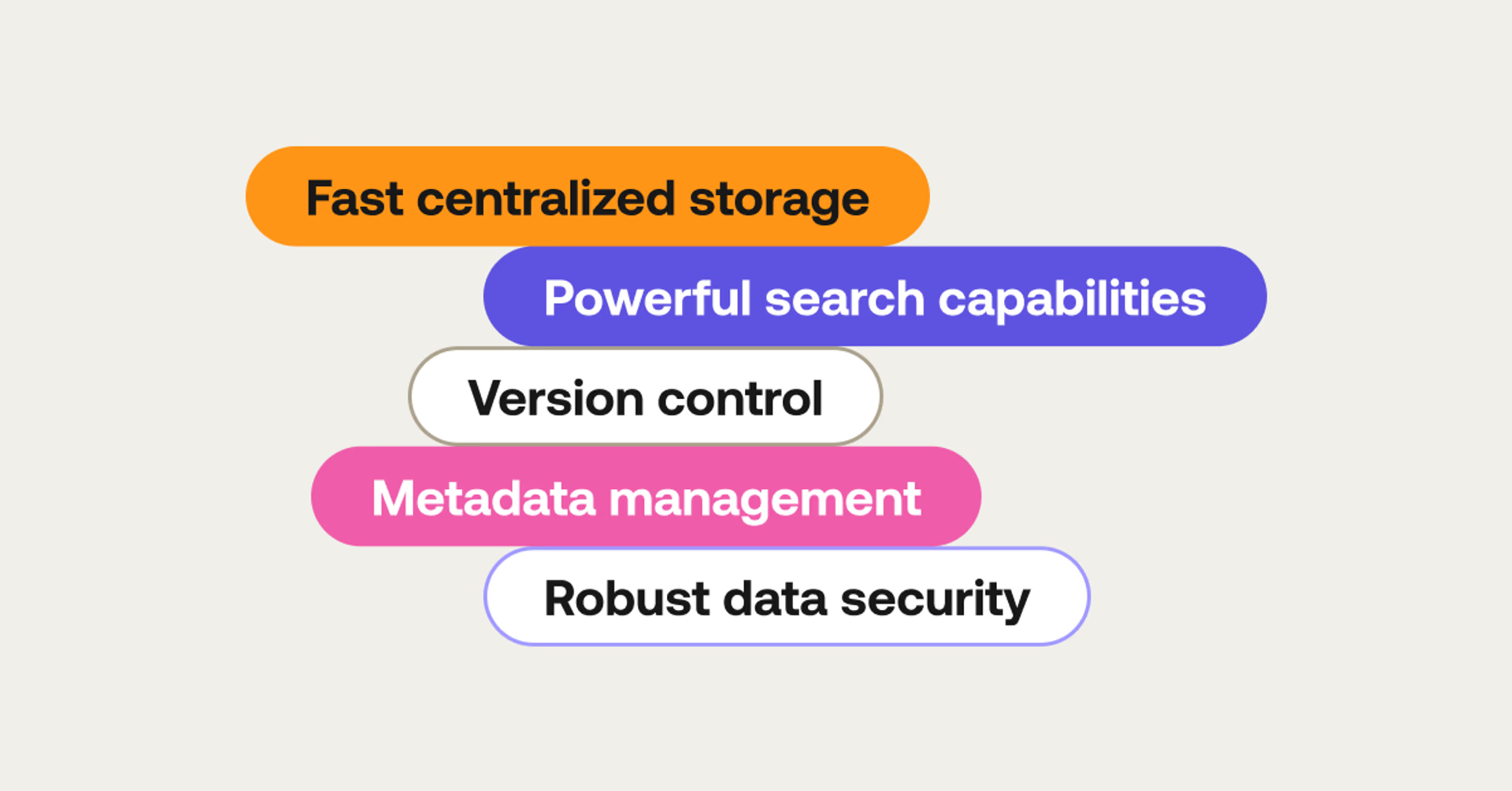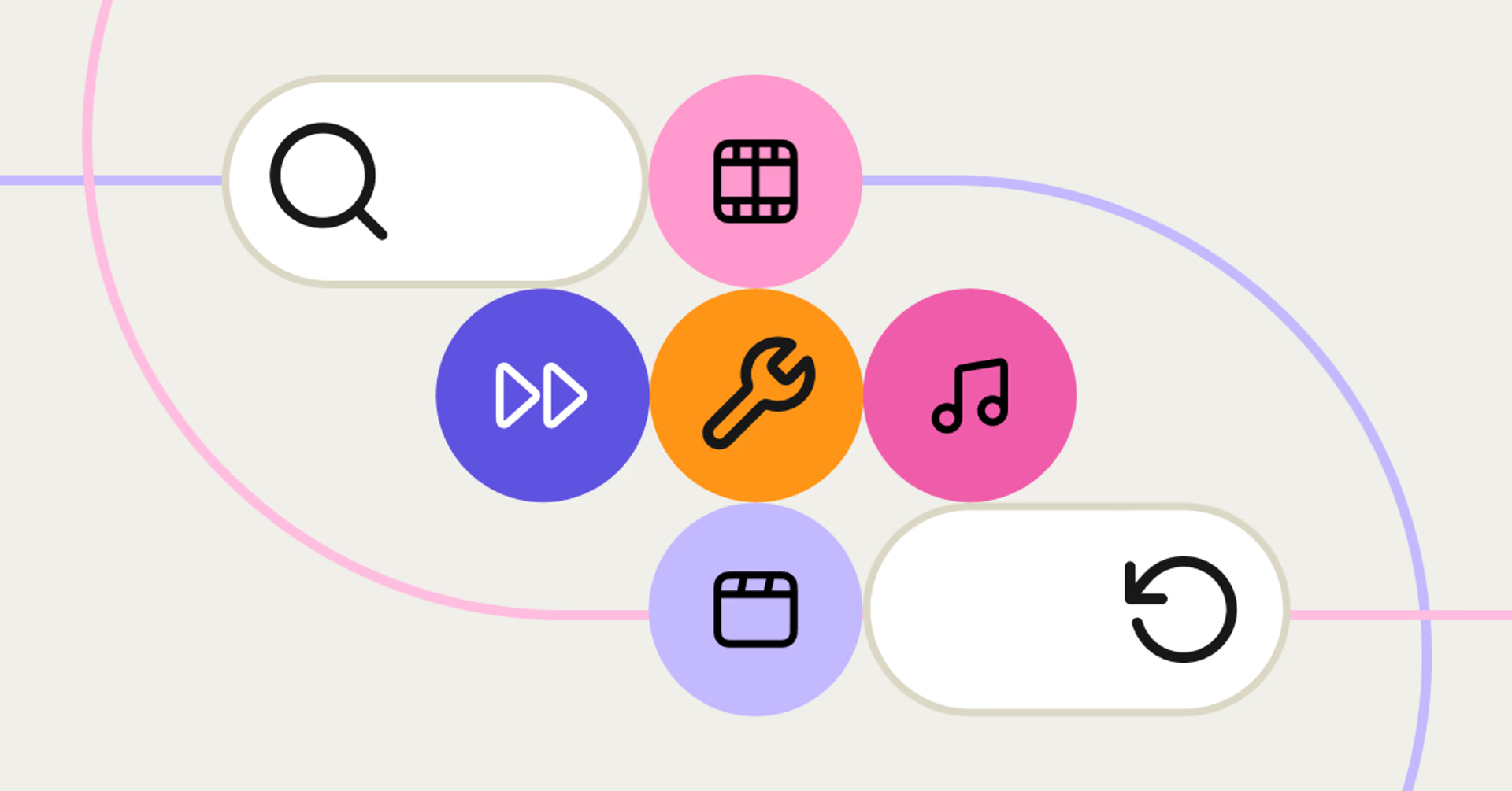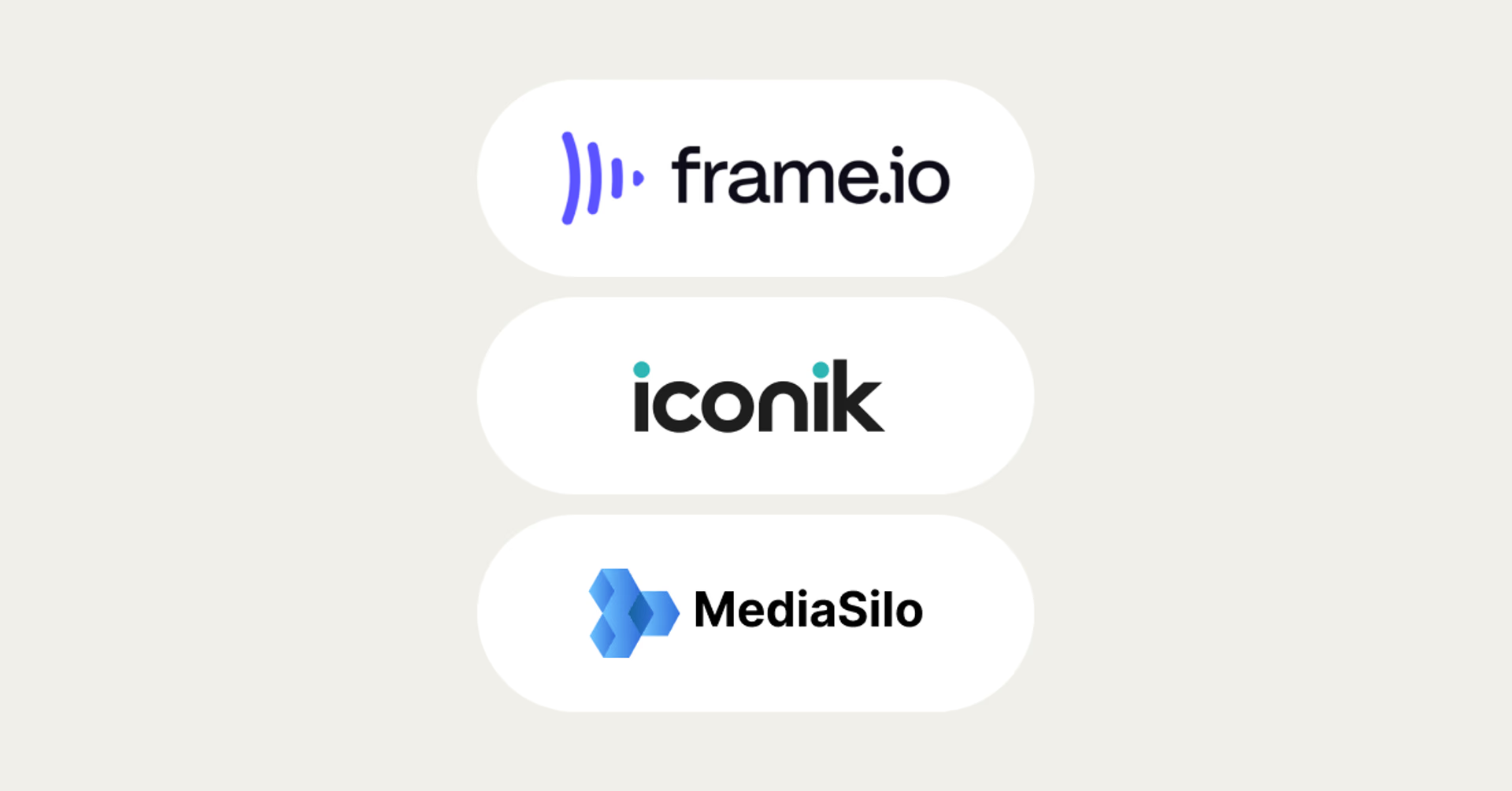Video asset management: how to make the most of your media assets
September 2024
8 mins

Table of contents
- What is video asset management?
- Video asset management vs. digital asset management
- How does video asset management work?
- How to choose video asset management software
- How LucidLink complements video asset management tools
- 6 best practices for effective video asset management
- Video asset management is a must-have
Just add LucidLink
No barriers to entry. Nothing new to learn. Known and familiar user interfaces that you choose for your team.
Start your free trialHow many hours did you waste this week looking for the perfect clip, only to find it buried at the bottom of an old hard drive, mislabeled and forgotten?
It’s probably best not to think about it.
Video asset management (VAM) is here to help. VAM can transform your sprawling video archive into a streamlined, searchable goldmine. It’s not just about storing media – smart VAM lets you instantly find any clip, collaborate with your team and squeeze more value from every frame you've ever shot.
Whether you’re a solo creator or global production house, VAM is reshaping how savvy editors work with video. In this guide, we'll unpack what VAM is, how it works and why it's crucial to your production workflows.
What is video asset management?

Video asset management is the process of using a specialized platform or software application designed to store, organize, find and make use of video content.
It’s the interface that lets you find the ‘needle in a haystack’ by precisely plucking the single media file you need from an archive potentially housing thousands of such files.
To achieve this, key features of a professional caliber VAM include:
Fast centralized storage
Powerful search capabilities
Version control
Metadata management
Robust data security
Working with a suitable video asset management platform helps you speed up your video production workflow by removing common bottlenecks. These include manually combing through hard drives, file structures and media files to find the files you need.
Video asset management also lets you make more content from your existing archive. This includes repurposing footage into B-roll for other projects or creating shorts from long-form source material. This is a smart way to make more with less – saving money and boosting profit.
Video asset management vs. digital asset management
Is there any difference between a DAM (digital asset management) and a VAM (video asset management) platform? Yes.
While VAM is indeed a subset of DAM, it has unique video-specific features that set it apart.
DAM is the overarching term for managing digital assets of all types – images, documents, audio files and videos. A VAM, however, is focused on the unique requirements of working with video content.
So why use VAM specifically?
Because video files demand special solutions due to:
Massive file sizes
Variable content duration
Specific video codecs and file formats
Video editing requirements
Collaboration bandwidth needs
VAM systems are built to handle these challenges, offering features tailored to video collaboration that general DAM systems might struggle to keep pace with.
How does video asset management work?

There are two main types of VAM. Software applications that can scan and index files stored on local storage and cloud-based platforms that both store and catalog your content.
All VAM systems function in the following way:
Ingest and metadata extraction: start by importing all your media into the system’s centralized storage, either manually or through an automated process. The VAM will then extract key metadata from the files such as file name, duration, media codec, resolution, date etc.
Newer VAM systems also use AI workflows to automatically extract information from the content of your video files, tagging them with the objects, people, locations, emotions and transcripted speech contained within.
Cataloging and storage: this is where a VAM shines. Your video content is organized and stored in a database and a systematic folder structure. This makes it easy to search and filter by tags, categories and folders in a logical fashion for your video production workflow.
Search: the success of your VAM system hinges on competent search capabilities. With all that metadata extracted and organized into a database, finding the right clip based on nuanced search terms and filters is quick and easy.
Version control: the system tracks changes to each file and can maintain multiple versions over time. Handy for undoing erroneous changes or catering to indecisive clients.
Collaboration: VAM platforms offer powerful collaboration features like file sharing, permission setting and commenting. LucidLink is perfect for this.
Sharing features and usage analytics: share search results or specific folders of video content with both internal team members and external collaborators. Analytics provide insight into how the system is being used, making resource allocation much more efficient.
Benefits of using a video asset management platform
Not every workflow needs a dedicated VAM. But when you do, the benefits are hard to ignore:
Centralized repository and a single source of truth: no more hunting through old hard drives or deciphering which version is the latest. Everything's in one place and reliably up-to-date.
Improved efficiency and organization: find what you need, when you need it.
Better collaboration and file security: work together to get the job delivered on time and keep your content safe from prying eyes.
Time and cost savings: Find what you need faster, share files quicker. It's like putting your workflow on steroids (the legal kind, of course).
Get more from your assets: Make more money from your existing assets through reuse and repurposing.
How to choose video asset management software
Selecting the right VAM for your video workflow needs will depend on numerous factors like context, budget and organization, but here are key features to consider:
User Interface: it should be intuitive and easy to use, for every type of user.
Storage capacity and location: make sure it can handle your total data needs, whether on-premise or in the cloud.
Search features: the heart of any decent VAM system. It should be powerful, flexible and fast.
Metadata extraction with AI: look for systems that can automatically generate transcripts, recognize objects and people and extract other useful metadata at scale.
Collaboration tools: features for link sharing, comments and user management are essential.
Integration capabilities: it should make using existing platforms and editing software even easier and more efficient, not less.
Data security and redundancy: your media is your livelihood. It needs to be securely stored and shared with round the clock back ups.
Scalability and customization: Your VAM should grow with you and adapt to your specific workflows, which may include hosting on various types of media storage.
Support, training and long-term costs: Don't forget to factor in these often-overlooked aspects of running a VAM.
Popular video asset management tools

Here are three popular VAM tools that can handle the demands of current video production and editing needs:
Frame.io
Pros
Camera to cloud ingest
Instant proxy generation
Excellent collaboration and sharing features
Fast global cloud storage
Direct video editing software integrations
Cons
Incompatible with on-premise storage
Limited search and metadata filtering features*
Expensive for large storage requirements
*This is being dramatically improved in the v4 beta.
iconik
Pros
Compatible with a mix of on-premise or media cloud storage
Fast and easy to use with native app integrations
AI powered transcription and tagging tools
Powerful API-enabled custom workflows
Cons
Extra security and AI features cost more
Complex pricing structure could make predictive budgeting difficult
Per-user fees can be expensive for large teams
MediaSilo
Pros
Atomos camera to cloud ingest
Comprehensive file-sharing
Custom branding options
Adobe creative app integrations
Extensive data security features
Cons
Only cloud-based
No AI analysis features yet
No pricing for individual users
How LucidLink complements video asset management tools
LucidLink is a storage collaboration platform, not a VAM. But our features make LucidLink complimentary to any VAM that can interact with other cloud-storage providers – creating faster and smoother user experiences and video workflows in the process.
You can check out how LucidLink integrates with iconik’s VAM platform in the video below.
Here’s why LucidLink and video asset management tools can be a perfect match for teams looking to streamline their workflows.
No downloads needed
With LucidLink you get instant access to your video files, regardless of their size or your location.
Our smart file streaming breaks down file data, delivering only the frames you’re actually playing back. This means your files are ready whenever you need them – there’s no waiting for downloads.
With other cloud-based DAM and VAM platforms, once you find the files you need you still need to download the source files in their entirety to start editing with them.
This can take a long time, especially with a large number of high-resolution source media files in a project.
Secure access on a global platform
LucidLink’s easy onboarding and file sharing make it an ideal platform for collaborative video editing, especially on fast turnaround remote video productions.
For example, one film editor produced 50 films in 5 weeks across 21 locations with LucidLink.
Adding users to a project gives them immediate access to files, without uploading or downloading anything. Meanwhile, zero-knowledge encryption ensures your media is always secure, in-transit and at rest. Other than the collaborators you give access, no one (including us) can see what’s in your files.
File snapshots also make it simple to revert to previous versions of files, so you don’t need to worry about accidental deletions.
Familiar workflows
Finally, as LucidLink looks and operates like any other local drive available on your desktop there’s no learning curve. And as the file and folder structure that is defined in the VAM is identical to how LucidLink stores the files, everything is where you expect it to be.
6 best practices for effective video asset management

If you’re looking to use a VAM, here are some best practices on how to make the most of it.
1. Consistent naming conventions and comprehensive metadata
These are the foundation of a well-organized system. Teams need to maintain a disciplined approach to the assets they upload.
2. Workflow automation
Set up systems that will run in the background to handle repetitive tasks such as ingest watch folders, archival egress and backups. Create presets for common search and filter combinations.
3. Backup and archiving
Local media assets will need to be backed up reliably. Not every asset will live in your VAM forever, having a process to archive old or unused media will trim costs and keep your content relevant.
4. Search optimization
Fine-tune your search capabilities. The better your search, the more accurate the results and the more efficient your workflow.
5. Integration with other systems
Your VAM should empower collaboration across your entire video production ecosystem. Regularly evaluate your workflow and incorporate new automations across services.
6. Training, maintenance and development
Your VAM will be useless if your team doesn’t know how to use it correctly or avoids using it due to inherent complexity. Also consider how your VAM requirements will scale over time.
Video asset management is a must-have
Video asset management is no longer a luxury. It's essential for any busy freelancer, small creative time or large organization serious about producing video content.
By centralizing your assets, automating your workflows and unlocking the full potential of your video library, VAM can transform your post-production workflow.
The benefits are clear: increased efficiency, better collaboration, enhanced data security and the ability to make more with your existing assets.
As VAM providers double down on AI capabilities like automatic B-roll selection, content edits and personalized workflows based on usage, the tech will only become more powerful.
With LucidLink on hand to supercharge any VAM’s performance, there’s never been a better time to organize your video assets.
Want instant access to files of any size, from anywhere? Try LucidLink for free.
Keep reading

How the cloud fuels storytelling: 5 takeaways from top creatives
Hear how top creatives use the cloud to collaborate in real time, streamline workflows and stay ahead.
24 April 2025, 4 mins read

Marketing video production guide: how to stand out & get results in 2025
Discover expert strategies for marketing video production. Learn how to create standout videos that engage your audience and drive real ROI.
28 February 2025, 8 mins read

Remote video production: a step-by-step guide
Discover the challenges, steps and tools needed for remote video production. Get advice to create remarkable remote productions in our comprehensive guide.
14 February 2025, 10 mins read
Join our newsletter
Get all our latest news and creative tips
Want the details? Read our Privacy Policy. Not loving our emails?
Unsubscribe anytime or drop us a note at support@lucidlink.com.